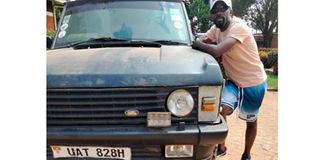Prime
My Range Rover Classic is worth the cost

Mugaga says his car easily negotiates turns, bends, and corners regardless of the weather. PHOTOs/Joan Salmon
What you need to know:
Purchased at Shs30m, Mugaga says he was willing to part with that much money because he has always loved this car and it is worth every penny
When one mentions a Range Rover, comfort, stability and finesse come to mind. SeaClark Mugaga is the owner of a Range Rover Classic 1994 hard dash, a car he has owned for the last five years. Purchased at Shs30m, Mugaga says he was willing to part with that much money because he has always loved this car and it is worth every penny.
The Range Rover classic started off as a luxurious option to the Land Rover and for many, it was the epitome of luxury, appealing to anyone that needed a classy car. The time and skill put in then means that while there are newer Range Rovers, the first generation make, with the familiar boxy shape has several supporters.
Mugaga appreciates his car for negotiating turns, bends, and corners seamlessly regardless of the weather.
“Being a four wheel drive makes it an excellent off-roader going over obstacles without much effort. This simply means that whether it is a muddy road, uphill, the vehicle will gladly take you wherever you want to go,” he says.
It is these capabilities that made Mugaga call it Samurai 1 (the beast) since it is reliable and a mighty off-roader as well as stable and firm, regardless of the terrain.
The vehicle comes with a 3.9 V8 engine, which gives a horsepower of 188Hp at 4,750rpm and torque of 319Nm at 3,100rpm. It also offers great speed, picking up from 0-60mph in less than 10 seconds if he wanted to rev the engine. That said, it does 130miles per hour, which is 220kph.

Fuel
However, Mugaga says that the 3.9 litre engine, in this current fuel crisis, will dig a hole into one’s pocket. “I use about Shs700,000 to fill it and since it is a weekend car, the full tank lasts a bit longer,” he says.
Interior
The five-door luxurious SUV’s interior is everything Mugaga loves and has added character to it by dressing the seats with custom-made leather seats. These also have his name ‘SeaClark’ neatly stitched on them. The leather makes them even more comfortable.
That is not forgetting how spacious the car is allowing for five adults to sit comfortably with enough leg and headroom. The seats can also be adjusted, allowing for one to relax, should the need arise.
Exterior
The edges are sharp making the vehicle look every bit wonderful. While most cars in the same bracket have racks, Mugaga has not added one. “It mainly works for people who go for long journeys and camping which I have not ventured into yet. In the long term, I would consider adding a rack,” he says.
He has also made some modifications on the indicator lights, adding aluminium alloy to make them stand out. He also changed the front lights bulbs for LED lights for better vision. On the left and right sides of the bonnet, he has added spring locks for safety purposes.
Maintenance
Mugaga services his car every 4000kms at a cost of Shs450,000. In case of any mechanical issues, he relies on his mechanic at Mukasa Stephens Garage in Ntinda, Kampala.
Spare parts for his well-maintained second-generation car are extremely rare. “I order most from the UK and all differ in prices,” he shares.
This particular Range Rover was Mugaga’s childhood dream car and he is thankful that he finally got it. “Inasmuch as it is a fuel-guzzling monster, it is a car everyone should drive,” he says.
About
Availability of the two-door version was restricted from 1984, but it remained in production for some markets until 1994, when the second generation was launched. From that moment, Land Rover rebranded the original model under the term «Range Rover Classic», to distinguish it from its new P38A successor, when the two were briefly built alongside, and applied the name retrospectively to all first-generation Range Rovers.





